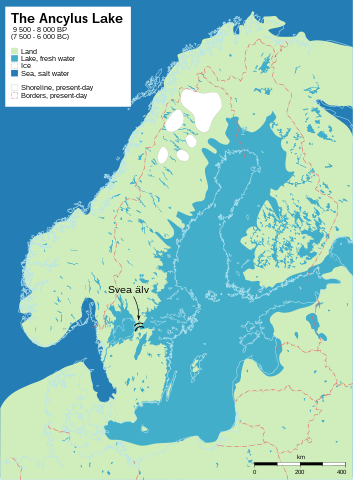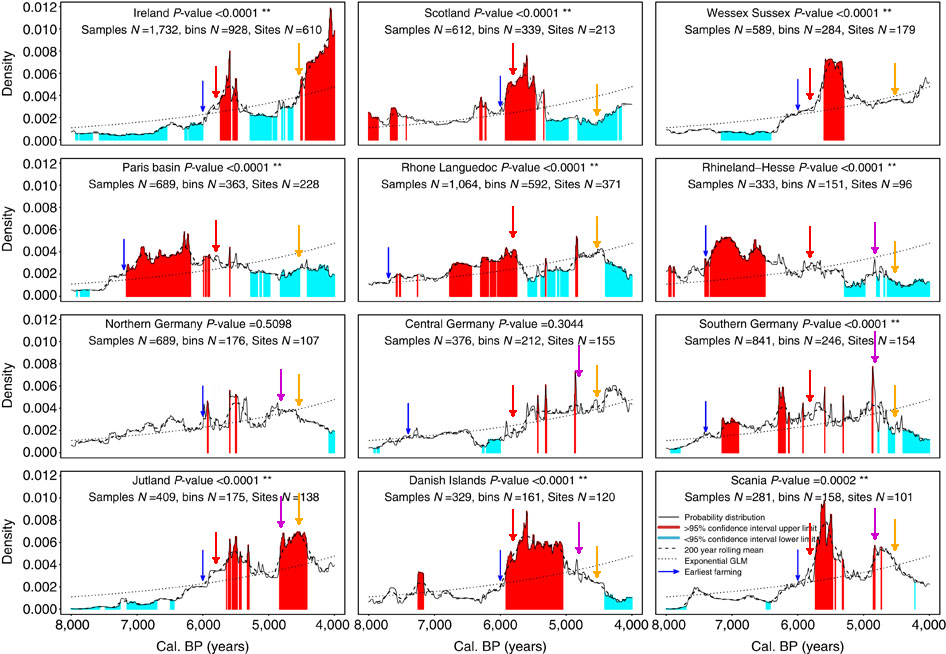Climate change during the Neolithic
Apparently, while nobody has anything to comment, people are still reading, so I continue with putting together some puzzle pieces. Whether they get us closer to solving the question why, as Brotherton's study has found out, most of the early Central European farmers died out, and who replaced them when - I don't know yet.
The European Neolithic experienced massive climate change. While after the end of the Ice Age, the climate had been similar to today, around 8,000 BC Europe got warmer and moister. By around 7,300 BC, average temperatures in Central and Northern Europe were some 0.5-2.5 °C higher than today. It is no coincidence that this climate optimum marks the beginning of the agricultural expansion from the Near East into Europe. Around 6,200 BC, the climate got markedly colder, but returned to the previous temperature levels around 6,000 BC. Furthermore, glacier melt had resulted in substantial sea level rise. Reduced glacier weight caused the underlying areas to rise, while those further away lost elevation. Combination of both factors resulted in flooding of the North Sea, the coastline of which reached today's West and East Frisian islands by around 6,000 BC. This also resulted in the Central European climate becoming more maritime, i.e. with milder winters and relatively humid springs and autumns. Nevertheless, overall higher temperatures are believed to have resulted in relatively long, hot summers, so the climate in the Middle-Elbe Saale region would have been more "Mediterranean", possibly comparable to today's climate in Hungary and Serbia. This second warm phase corresponds to the LBK expansion into Central Europe.
The northern periphery of the Elbe-Saale region at that time looked quite different from today. Melt water from Scandinavian glaciers had created a giant freshwater lake, the Ancylus Lake, in the area of today's Baltic Sea. A land bridge extended from East Holstein via the Danish isles to Southern Sweden. Ancylus Lake was connected to the North Sea via the Svea river, Lake Vanern and the Göta river. Motala, where a 6,000 BC grave of HGs has been found (Lazarides' NHG, 6x mtDNA U5a*, plus one U2e1) is located slightly south of the eastern end of this outlet.
During the 6th millennium BC, further sea-level rise caused the land bridge to break, gradually connecting the Ancylus lake to the North Sea - first as brackwater lake (Litorina Sea), then gradually developing into today's Baltic Sea. Recent investigations have clarified the timing and sequence of this transgression:
http://www2008.io-warnemuende.de/documents/mebe67_2006-roessler.pdf
New cores were drilled west and east of the Darss Sill, the Mecklenburg Bay and the Arkona Basin, to investigate the transition from the fresh water conditions of the Ancylus Lake to the marine-brackish conditions of the Littorina Sea in a high spatial and temporal resolution.In general, Arkona Basin sediments display more abrupt shifts in the proxy parameter at the transition from Ancylus Lake to Littorina Sea stage material than those from the Mecklenburg Bay. Radiocarbon dating on calcareous material indicates that marine waters entered the Mecklenburg Bay first at c. 7,500 14C yr BP and the Arkona Basin approximately 1,000 years later at c. 6,500 14C yr BP. These results therefore suggest a transgression pathway via the Great Belt into the Mecklenburg Bay and then into the Arkona Basin.
In a yet not fully understood way, flooding of the North and Baltic Sea, and associated changes in Atlantic currents, had profound effects on the North-West European climate. A short global cooling around 5,200-5,100 BC is observable in Greenland ice cores and the Near East, but not in Scandinavia. It may, however, have affected areas further south. There is indication of late LBK societies as far apart as the Paris Basin, the middle Rhine, Saxony and Upper Austria reverting to ritualised cannibalism by the end of the 6th millennium, interpreted as symptom of a deep crisis that shook societies during the late LBK period.
http://www.academia.edu/1403683/Can...ttery_culture_at_Herxheim_Palatinate_Germany_
Following a short recovery, temperatures on the northern hemisphere started to gradually decline from around 4,700 BC on due to a slight tilt in the earth axis. In addition, major volcanic eruptions (e.g. Mt. Hudson 4,750 BC, Kikai Caldera 4,400 BC) may have played a role. Some authors place the transition from the Atlantic to the Subboreal climate period here, others at 4,000 or even 3,710 BC. This again is related to obvious strong regional differentiation. Scandinavia, e.g., became only slightly cooler but substantially dryer after 4,800 BC (though volcanic winters around 4,400 are apparent), while Alpine glaciers start to grow, and sediment analysis from the upper and middle Vistula basins indicates a substantial increase in flooding frequency and intensity between 4,650 and 4,050 BC. This generally corresponds to the Central European archaeological record of post-LBK cultures (Rössen, Lengyel, Michelsberg etc.) having retreated from the river areas towards hill settlements. Forest coverage gradually decreases, possibly due to intensified pastoral and agricultural use.
http://hol.sagepub.com/content/5/1/34.abstract
Around 4,100 BC, Scandinavia gets much cooler (though still 1°C warmer than today) and slightly wetter, and Central Europe warmer and dryer again. Possibly triggered by two major volcanic eruptions (Masaya, Pago), around the turn of the 4th millennium Central Europe enters a cool and dry phase that lasts for around 300 years, and corresponds to massive deforestation. Swiss glaciers grow to an extent similar to the 16/17th century "little ice-age".
By around 3,650 BC, Central Europe and Scandinavia revert to a warmer and wetter climate. The African humid period in the Sahara, however, comes to an end, and the Aegean encounters one-hundred years of drought. While climatic patterns apparently vary, it is tempting to speculate that this drought could also have affected the northern Black Sea, and played a role in the replacement of the Dnieper-Donetsk culture by the Yamna culture around 3,500 BC.
The last major climate change in the period in question here was the Piora cold period between 3,200 and 2,900 BC. Alpine glaciers grew suddenly and massively, and the Eifel (NW Germany) saw a sudden drop of average temperature by 1°C, coupled with milder winters and increasing precipitation. Flooding frequency on the Vistula increased. Elsewhere, the water level of the Dead Sea rose by 100m, some historians also link the fall of Uruk in Mesopotamia to this climatic anomaly. Scandinavia again appears to have been hardly affected. Note that the Salzmünde culture, with its specific burial practices that may have included human sacrifice and ritual cannibalism falls into this period.
http://www.eupedia.com/forum/newreply.php?do=postreply&t=30209
After the end of the Piora cold phase, Central Europe seems to have enjoyed a relatively stable climate similar, though slightly warmer to the one today that lasted until around 1,800 BC, with temperatures gradually decreasing and precicipation / flooding increasing after 2,500 BC.
The diagram below displays cyclical temperature changes in the Atlantic (Bond cycles), the red is the temperature read from Greenland ice core. Yellow lines mark the different cycles, but they also correspond pretty well to our understanding of historic phase. Note the Greenland temperature drops around 5,200 BC (LBK crisis), 3,700BC (Aegean drought) and 3,200 BC (Piora cold period).
Further reading (nice diagrams):
http://www.dandebat.dk/eng-klima7.htm
http://www.academia.edu/3584928/Men..._in_Mitteleuropa_in_Vergangenheit_und_Zukunft







